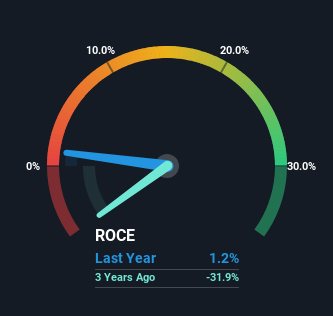Questerre Energy (TSE:QEC) Shareholders Will Want The ROCE Trajectory To Continue
If you're not sure where to start when looking for the next multi-bagger, there are a few key trends you should keep an eye out for. One common approach is to try and find a company with returns on capital employed (ROCE) that are increasing, in conjunction with a growing amount of capital employed. This shows us that it's a compounding machine, able to continually reinvest its earnings back into the business and generate higher returns. With that in mind, we've noticed some promising trends at Questerre Energy (TSE:QEC) so let's look a bit deeper.
Understanding Return On Capital Employed (ROCE)
If you haven't worked with ROCE before, it measures the 'return' (pre-tax profit) a company generates from capital employed in its business. The formula for this calculation on Questerre Energy is:
Return on Capital Employed = Earnings Before Interest and Tax (EBIT) ÷ (Total Assets - Current Liabilities)
0.012 = CA$2.4m ÷ (CA$198m - CA$9.1m) (Based on the trailing twelve months to September 2023).
So, Questerre Energy has an ROCE of 1.2%. Ultimately, that's a low return and it under-performs the Oil and Gas industry average of 9.8%.
Check out our latest analysis for Questerre Energy
Historical performance is a great place to start when researching a stock so above you can see the gauge for Questerre Energy's ROCE against it's prior returns. If you're interested in investigating Questerre Energy's past further, check out this free graph of past earnings, revenue and cash flow.
What Can We Tell From Questerre Energy's ROCE Trend?
Questerre Energy has broken into the black (profitability) and we're sure it's a sight for sore eyes. The company now earns 1.2% on its capital, because five years ago it was incurring losses. Interestingly, the capital employed by the business has remained relatively flat, so these higher returns are either from prior investments paying off or increased efficiencies. With no noticeable increase in capital employed, it's worth knowing what the company plans on doing going forward in regards to reinvesting and growing the business. So if you're looking for high growth, you'll want to see a business's capital employed also increasing.
One more thing to note, Questerre Energy has decreased current liabilities to 4.6% of total assets over this period, which effectively reduces the amount of funding from suppliers or short-term creditors. This tells us that Questerre Energy has grown its returns without a reliance on increasing their current liabilities, which we're very happy with.
The Key Takeaway
To bring it all together, Questerre Energy has done well to increase the returns it's generating from its capital employed. And since the stock has fallen 24% over the last five years, there might be an opportunity here. So researching this company further and determining whether or not these trends will continue seems justified.
If you want to know some of the risks facing Questerre Energy we've found 4 warning signs (1 is concerning!) that you should be aware of before investing here.
While Questerre Energy may not currently earn the highest returns, we've compiled a list of companies that currently earn more than 25% return on equity. Check out this free list here.
Have feedback on this article? Concerned about the content? Get in touch with us directly. Alternatively, email editorial-team (at) simplywallst.com.
This article by Simply Wall St is general in nature. We provide commentary based on historical data and analyst forecasts only using an unbiased methodology and our articles are not intended to be financial advice. It does not constitute a recommendation to buy or sell any stock, and does not take account of your objectives, or your financial situation. We aim to bring you long-term focused analysis driven by fundamental data. Note that our analysis may not factor in the latest price-sensitive company announcements or qualitative material. Simply Wall St has no position in any stocks mentioned.

 Yahoo Finance
Yahoo Finance 
